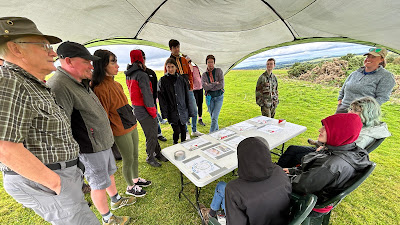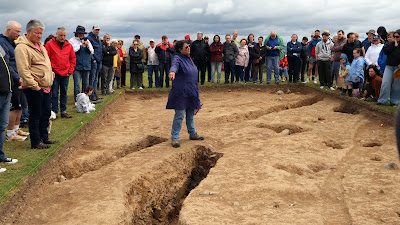Big attendance at last Dun Ailinne Open Day
With around 150 people trekking to the top of Dun Ailinne yesterday afternoon, it was a really good turnout for what was the last Open Day on the hill for the foreseeable future, writes Brian Byrne. The annual summer excavations by groups of American archaeology students have been a fixture of Kilcullen life since 2016, but these have come to an end this year.
“It’s not that we have found everything; there are two or three lifetimes of work which could still be done on Dun Ailinne,” says Dr Susan Johnston from George Washington University, who, with her colleague Dr Suzanne Garrett, has been leading the investigations on the ancient site for almost two decades. "When we did the geophysics, we found there are hundreds of little circles and squiggles and things that you could investigate. But as far as the archaeology goes, I feel I'm at a stopping point; I've done this thing. The next stage is to write up the findings for publication in a formal way. The goal is to do that for next year.”
 |
| Dr Suzanne Garrett and Dr Susan Johnston. |
The work over the years has confirmed the results of the excavations by Dr Bernard Wailes in the late 1960s and early 1970s, and also found significantly more areas of interest under the topsoil of Dun Ailinne. "In addition to those structures discovered by Bernard, we found three more that are slightly smaller, but with a similar pattern of getting more and more elaborate with time."
The use of technologies which weren’t available to Dr Wailes’s investigations, including magnetometry and carbon dating, has added to the bank of knowledge about the site. For instance, Susan Johnston now believes the active period of Dun Ailinne as a place of ritual may have been as short as around 200 years. But that doesn’t diminish its importance as one of the royal sites that are collectively on Ireland’s Tentative List in consideration for UNESCO World Heritage status. "The argument has always been, and I think there's merit to it, is that when Christianity comes in, this place gradually becomes less relevant in ritual terms. But it's still important in historical ways, and I think it's pertinent that they put the Christian monastery on a different hill, instead of plonking it here."
The fact that Dun Ailinne is continuously mentioned in documents from after the early medieval period is significant, she feels. "It's a place that is never really forgotten, a place of importance, and even when O'Donovan came through with his ordnance survey in the 19th century, he said that everybody knows this is Dun Ailinne. So even though it's not in continuous use, it's still known and is still important."
 |
| Vanessa and Claire. |
Since 2016, Dun Ailinne has been a place for American archaeology students to get down and dirty for a month in the summer and see what field excavations in Ireland are like. This year, six of the cohort were from George Washington University and one from Gettysburg College. For Vanessa, majoring in archaeology and history, and Claire, majoring in anthropology, their first field experience has been both fascinating and enjoyable. "You get thrown into it completely," says Vanessa. "At first it's very heavy work, digging the sod and then you get down and doing more delicate work with the trowel and it's so exciting to see all the features come up."
For Claire, having the practical experience has helped her to really understand things previously only covered in a classroom. "You have so much more a connection to it when you're actually doing it, and that's been great," she says. Both students say the Kilcullen sojourn — "it's such a cute town, with the river running through it," Claire says — will encourage them to continue in their fields. "I've had such a great experience here," says Vanessa, "and it has been really cool to get to see history up close and learn about it."
The tours of the 13-hectare site conducted by Susan Johnston yesterday reflected both her four decades as a teacher and the underlying humour of her personality, which has a refreshing irreverence. It was very much a two-way interaction as she answered questions and built up a picture of the site's probable role in community identity and hierarchy in a mobile cattle and agriculture economy. Although there's no evidence that Dun Ailinne was a place where kings were inaugurated, as at other royal sites, she suggested that it was used to 'anchor' people through annual or semi-annual rituals, and was still about important people. "The idea is that you're moving around, but you're still part of a community. And every year, perhaps at Bealtaine or whatever, people come back here and do various kinds of rituals. That's what gives them their sense of community, that they are all part of the same group."
Almost like the place Dun Ailinne was for its own mobile community two thousand years ago, the annual arrival of Susan Johnston and her team to Kilcullen has been its own anchoring of connections since 2006. Now that the current investigations have come to an end, the archaeologists have mixed feelings. But a constant is their view of Kilcullen and its people, especially the Thompson family who own the Dun Ailline land and gave their permission readily for the excavations. "They have been so incredibly good all over the years," Susan Johnston says. "And this community is amazing, and I will miss that. I'll be coming back, but, you know, it won't be quite the same."
 |
| Explaining the finds on Dun Ailinne. |
NOTE: Dun Ailinne is on a private working farm and not open to the public.
Photographs use Policy — Privacy Policy


































